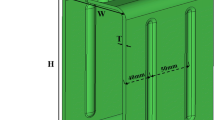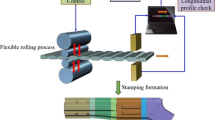Abstract
This work introduces an optimization procedure derived from the targeting force-displacement response (TFDR) method to improve the crashworthiness of full-size vehicle structures. The proposed method aims at targeting the vehicle’s acceleration-time response (ATR) under a crash event using topometry (thickness) optimization. In contrast to the original TFDR method, the proposed targeting method uses a moving coordinate system (MCS) that allows addressing fully dynamic crash models with initial velocity. By setting a proper target ATR curve, the proposed method can improve several crashworthiness indicators including specific energy absorption, maximum deceleration, dynamic penetration, and crash load efficiency. The result of the topometry optimization could be a guideline for the further design. In the proposed method, the nonlinear optimization problem is discretized into a series of analytical subproblems using equivalent dynamic load (EDL). In each iteration, the dynamic response from an explicit dynamic finite element (FE) analysis is utilized to define and solve a subproblem. To demonstrate the proposed iterative method, the baseline FE model of a Dodge Grand Caravan vehicle, obtained from the US National Highway Traffic Safety Administration (NHTSA) website, is optimized. The results show the effectiveness of the algorithm finding the element thickness distribution to make the acceleration-time response of the vehicle’s center of gravity (VCG) gradually approach a target curve. The proposed EDL algorithm finds a converged solution using less than 15 crash simulations. This makes it possible to solve problems involving full-size vehicle FE models.


















Similar content being viewed by others
References
Avalle M, Chiandussi G, Belingardi G (2002) Design optimization by response surface methodology: application to crashworthiness design of vehicle structures. Struct Multidiscip Optim 24(4):325–332
Gao YK, Sun F, Yu HY (2010) Crashworthiness optimization of car body based on kriging surrogate model. Automot Eng 32(1):17–21
Han X, An W, Tovar A (2019) Targeting the force-displacement response of thin-walled structures subjected to crushing load using curve decomposition and topometry optimization. Struct Multidiscip Optim 59:2303–2318. https://doi.org/10.1007/s00158-019-02197-8
Hong E, You B, Kim C, Park G (2010) Optimization of flexible components of multibody systems via equivalent static loads. Struct Multidiscip Optim 40(1–6):549–562
Jones DR, Schonlau M, Welch WJ (1998) Efficient global optimization of expensive black-box functions. J Glob Optim (13):455–492. https://doi.org/10.1023/A:1008306431147
Jung DY, Gea HC (2004) Topology optimization of nonlinear structures. Finite Elem Anal Des 40(11):1417–1427
Kurtaran H, Eskandarian A, Marzougui D, Bedewi NE (2002) Crashworthiness design optimization using successive response surface approximations. Comput Mech 29(4–5):409–421
Lan F, Zhong Y, Zhuang L, Chen J, Fang Z (2010) Optimization of energy-absorbing members in front-end of car body based on adaptive response surface method. Automot Eng
Levia JP (2004) Topometry optimization: a new capability to perform element by element sizing optimization of structures. AIAA/ISSMO Multidisciplinary Analysis and Optimization Conference
Liu K, Wu T, Detwiler D, Panchal J, Tovar A (2019) Design for crashworthiness of categorical multimaterial structures using cluster analysis and Bayesian optimization. ASME J Mech Des, Spec Issue Mach Learn 141(12):121701
Marklund PO, Nilsson L (2001) Optimization of a car body component subjected to side impact. Struct Multidiscip Optim 21(5):383–392
Mozumder C, Tovar A, Renaud JE (2010) Topometry optimization of plastically deformable sheet-metal structure with prescribed force-displacement response for controlled energy absorption. 51st AIAA/ASME/ASCE/AHS/ASC structures, structural dynamics, and materials conference 18th AIAA/ASME/AHS adaptive structures conference 12th
Mozumder C, Tovar A, Renaud JE (2012) Topometry optimization for crashworthiness design using hybrid cellular automata. Int J Veh Des 60(1,2):100–120
Park GJ (2011) Technical overview of the equivalent static loads method for non-linear static response structural optimization. Struct Multidiscip Optim 43(3):319–337
Park GJ, Kang BS (2003) Validation of a structural optimization algorithm transforming dynamic loads into equivalent static loads. J Optim Theory Applic 118(1):191–200
Redhe M, Forsberg J, Jansson T, Marklund PO, Nilsson L (2002) Using the response surface methodology and the d-optimality criterion in crashworthiness related problems. Struct Multidiscip Optim 24(3):185–194
Xu F, Wan X, Chen Y (2017) Design optimization of thin-walled circular tubular structures with graded thickness under later impact loading. Int J Automot Technol 18(3):439–449
Zhang Q, Zhao L, Zhang Q, Wei X (2015) Geometry parameter optimization method for automobile energy-absorbing box, 2015 4th. International Conference on Computer Science and Network Technology (ICCSNT), Harbin, China, pp. 295–299. https://doi.org/10.1109/ICCSNT.2015.7490755.
Zhang X, Zhang H, Wang Z (2016) Bending collapse of square tubes with variable thickness. Int J Mech Sci 106:107–116
Author information
Authors and Affiliations
Corresponding author
Ethics declarations
Conflict of interest
The authors declare that they have no conflict of interest.
Replication of results
The LS-DYNA input deck files for the finite element model of the Dodge Grand Caravan vehicle can be downloaded from the US National Highway Traffic Safety Administration (NHTSA) website (https://www.nhtsa.gov/crash-simulation-vehicle-models). The MATLAB code to read the LS-DYNA output deck files and apply the proposed EDL optimization approach can be made available upon request to the authors.
Additional information
Responsible Editor: Palaniappan Ramu
Publisher's note
Springer Nature remains neutral with regard to jurisdictional claims in published maps and institutional affiliations.
Rights and permissions
About this article
Cite this article
An, W., Han, X., Tovar, A. et al. Targeting the acceleration-time response of vehicle structures under crash impact using equivalent dynamic loads. Struct Multidisc Optim 64, 599–612 (2021). https://doi.org/10.1007/s00158-021-02845-y
Received:
Revised:
Accepted:
Published:
Issue Date:
DOI: https://doi.org/10.1007/s00158-021-02845-y




